And just like that, it’s the future.
When last we spoke, I was prone to foolish statements like “Green will never get a seriously upgraded Withered Wretch that’s a Raccoon” and “Wizards won’t print a Shadow the Hedgehog card.” We had just visited Middle-Earth, had lost Fury in Modern (Grief’s day was yet to come), and Universes Beyond was still siloed to Commander and eternal formats. Billie Piper had cameoed on a Magic card, Sheldon Menery was about to, and BD Wong distinctly did not. I had an infant, an unproduced play, and a meticulously designed Cube list. Now I have a toddler, a different unproduced play, and three meticulously designed Cubes. Things may change, but some trends are predictable.
In the last year and a half, Magic has been to the Lost World, the Wild West, the racetrack, and now, like Jason Voorhees before it, heads to space for the elevated sci-fi of Edge of Eternities. It’s a bit jarring to jump from one aesthetic to the other, but, whereas Aetherdrift or Outlaws of Thunder Junction’s settings were arguably dissonant with what Magic has historically been, Edge of Eternities is more resonant, paradoxically, with Magic’s past.
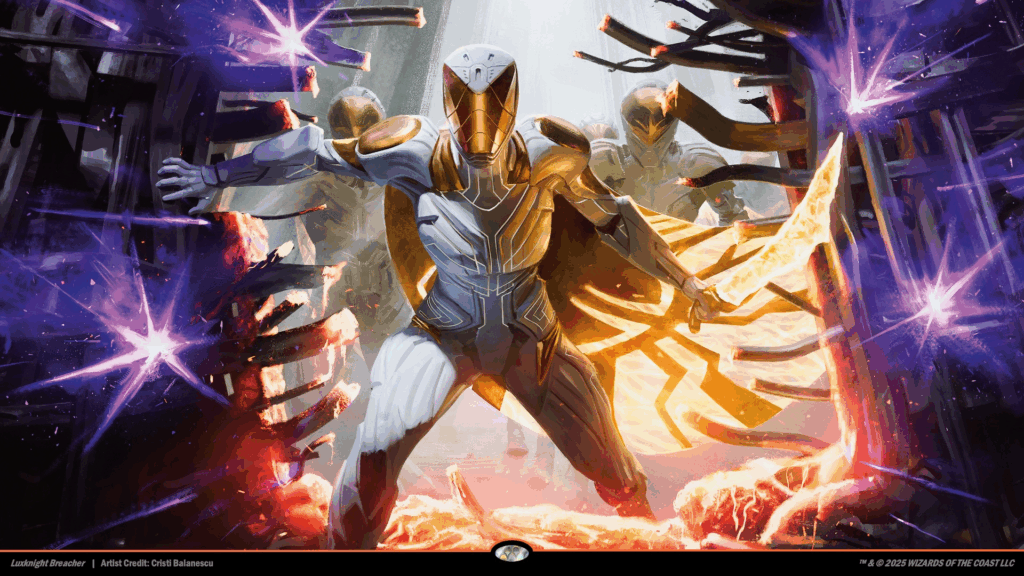
Luxknight Breacher by Cristi Balanescu
Seeing Ourselves in Science Fiction
Nothing is more tedious than the endless categorization battles—science-fiction versus speculative fiction versus genre fiction, etc. Still, it’s important, as science fiction teaches us, to have a shared language on which to build relationships. Let’s define what we talk about when we talk about “sci-fi.”
Personally, my aesthetic definition of science fiction would be art or media that involves:
- Advanced technology, specifically human cultural or evolutionary responses to technology.
- The scale of humanity contrasted with the scale of the cosmos.
I’m sure that, given a couple of hours, I could easily find two dozen bona fide paragons of science fiction that challenge this definition, thus invalidating it, but let’s roll with it for now.
Art is always affected by the context and the culture of the artist. Some of the finest works of science fiction, though, are praised because of how far afield they go from that context. Dune, Parable of the Sower, The Expanse, Gundam—these are all masterworks that are clearly affected by terrestrial influence, but by distancing their arguments from the human mundane, they can increase their impact. By creating other worlds, we can contrast or examine our own. Essentially, science fiction is a medium that uses alternate, projected, or imaginative realities to contextualize our current and historical realities. So what’s more important about science fiction is what it allows us to do. It allows us to interpret what we have made the world and our societies into by allowing for alternate outcomes. It allows us to imagine freedoms that have been hidden or taken from us. It allows us to see humanity as one facet of sentience, and to imagine how we would present our species to outsiders.
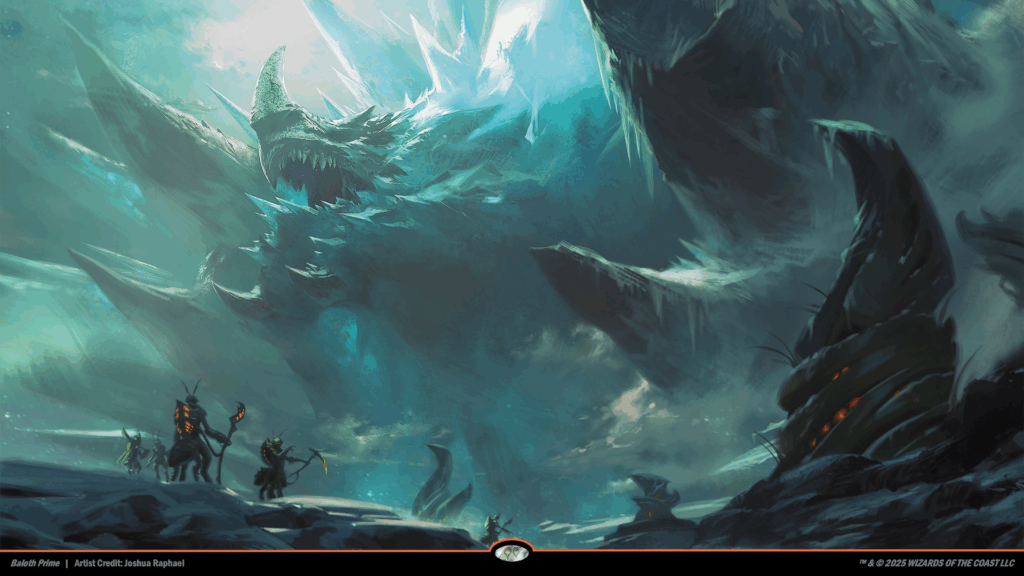
Baloth Prime by Joshua Raphael
Is Edge of Eternities science fiction, per my definition? Absolutely—we have advanced technology, including faster-than-light travel and science based on observation at the quantum level. Other sci-fi signifiers include cultural clashes between civilizations, and a starfarers’ regulatory agency that’s alternately benign and cryptopaternalistic in the Pinnacle. The Planeswalker’s Guide to Edge of Eternities is encouragingly jargon-heavy and crunchy. The cards reference astrophysics, and there are glowing control panels on every surface and city-sized dreadnoughts overhead.
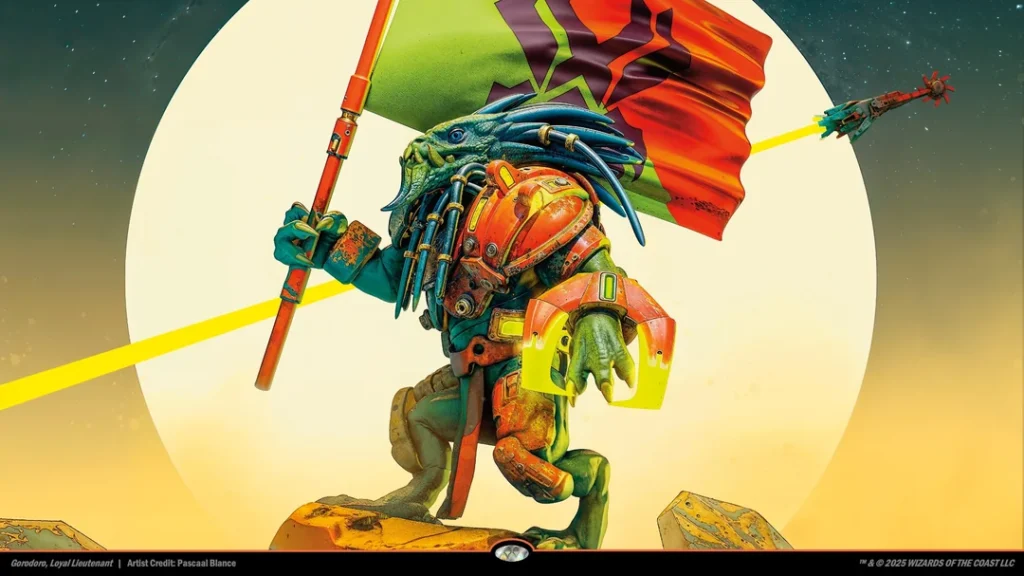
Gorodoro, Loyal Lieutenant by Pascaal Blance
Edge forces us to recontextualize traditional Magic through the prism of science fiction, from the reskinned shocklands (weirdly, a return to something we already saw in Unfinity) to the reappearing Kavu and references to Slivers, to understanding what the colors of Magic look like beyond just “Black cards are tied to swamp planets.” There are, no doubt, surprises and Secret Lair tie-ins coming, but from what we’ve seen from initial reveals, Edge of Eternities is not trying to throw us out of the airlock without a tether. A Kavu in a spaceship is not something we’ve seen before, but otherwise, Edge looks closer to Kamigawa: Neon Dynasty than Unfinity or Aetherdrift. The mechanics of Edge trend conservative—a modified Revolt in Void, a modified Investigate in Landers, a modified Crew in Station, a modified alternate cost for permanents in Warp. That’s not a slight against the set, rather praise for keeping things familiar in a setting that could potentially turn off Magic’s more fantasy-minded audience (NB: I’m in the audience. I want orcs and ghouls, but I don’t mind a brief sojourn into other aesthetics).

Broad Strokes about Edge of Eternities
Historically, drawing a card is worth two generic mana. Older cantrips were a simple spell plus two colorless for a fresh card—compare Unsummon to Repulse or Raise Dead to Recover. As Magic continued to iterate upon past designs, this shifted a bit to include more minor or restrictive effects without preexisting cards like Aphotic Wisps or Aura Finesse up to Investigate cards that create a Clue, which is effectively Seal of Cantrip.
Clues are interesting. While they seem to just be a time-delayed cantripping effect, trading in two generic mana for a card, the fact that they turn on Metalcraft, trigger Marionette Master, count for Ascend and Affinity, are insulated against discard effects, etc. can be situationally more powerful.

A Lander token is a Seal of Rampant Growth with similar implications. Notably, unlike with cantrips, Green is the only color with access to Rampant Growth—while every color can run Wayfarer’s Bauble, there’s an opportunity cost to having Baubles in your deck—and so Lander tokens can be huge for control decks, like Thawing Glaciers was back in Magic’s antediluvian days.
Contrasting to cantrips, though, is the fact that it’s possible to run out of basic lands to find, as any Modern player who has been hit multiple times with Paths to Exile can tell you. I’ve been running three-color decks in current Standard that run as few as five basics, and so Lander tokens are of minimal use. Still, anything that smooths mana, potentially thins your deck, and triggers Landfall is worth paying attention to—particularly as there have been Standard formats where Rampant Growth was considered too powerful or homogenizing.

Vehicles are in an ugly spot. If the Crew cost is negligible (Smuggler’s Copter, Esika’s Chariot) they’re too powerful, but, as with Battles, you’d rather be attacking your opponent with your high-powered creatures than tapping them for a one-turn animation effect. In general, it just sequences poorly.
Station is an attempt to fix this by letting your creatures level up a Spacecraft—at the Station threshold, it becomes an artifact creature permanently. This can still be a blowout, but The Seriema at least provides a tutor on entering and protects any Legendary creatures you tapped to animate it (and is immune to Go for the Throat on several levels, including rotation). There will be at least 400 Legendary Creatures legal in Standard after Edge of Eternity enters the format, and any high Station costs may have us revisiting The Mindskinner, Anzrag, the Quake-Mole, The Ancient One, Kalakscion, Hunger Tyrant, or Hazoret, Godseeker.

After Aetherdrift, I’m leery of including too many Vehicles in any deck—the memories of terrible 13 creature, five Vehicle decks are too fresh—but I’m glad Wizards continues to explore the space. I worry that Spacecraft will end up closer to the March of the Machine Battles—if you have enough power on the board to hit the Station threshold, wouldn’t you rather be attacking?—but at least it gives tokens and outclassed or Warped creatures something to work towards. It does provide a quick way to tap Reluctant Role Model or Kona, Rescue Beastie, but we haven’t exactly lacked for those since Aetherdrift, and a deck has yet to emerge.

Warp plays around with a space initially explored in Foretell, Evoke, and Blitz, which is interesting territory. Anything that lets you cast permanents at a discount has historically been powerful, and Warped permanents can be Flickered or Blinked to ensure they stick around. I love a hybrid spell/creature card, from Man-o’-War to Mulldrifter, and so Mechanozoa seems like an early pick. Outside of Limited, the utility of Warp cards seems restrained, but anything that lets you a) get a discounted effect on a body and b) cast spells from exile is worth watching.

Void is Revolt with a couple of key distinctions. The actual text is “At the beginning of your end step, if a nonland permanent left the battlefield this turn or a spell was warped this turn, then…,” which, unlike Revolt, doesn’t restrict you to your permanents. This is an upgrade, balanced by the fact that fetchlands won’t trigger Void. Greenwheel Liberator never panned out, so I don’t have high hopes for the mechanic outside of Limited, but there is a big difference between Revolt requiring a sacrifice outlet or a suboptimal combat phase and Void requiring either a removal spell or a Warped card. Treasure tokens, Lander tokens, Beseech the Mirror, Sephiroth—there are certainly outlets enough to trigger Void, now we just have to see what cards with the mechanic are worth the work.

Of the cards previewed so far–minimal, as we’ve just seen the debut stream and a trickle of officially-revealed previews–the one that interests me most is Cosmogoyf. How big does a Cosmogoyf need to be playable? Hitting GB on turn two is plausible in a world of Overgrown Tomb, Blooming Marsh, Wastewood Verge, and Underground Mortuary, and there are enough exile-for-a-benefit cards in future Standard to make a deck (Agatha’s Soul Cauldron, Ketramose, Molt Tender, Abhorrent Oculus). But if your 7/8 that you spent a turn or two setting up just eats a Bitter Triumph or is chump-blocked by infinite Rabbits, what was the use of it? I’ve enjoyed playing Souls of the Lost over the last year and change, but that was easier to cast and fueled itself. I don’t have high hopes for Starmogoyf here.
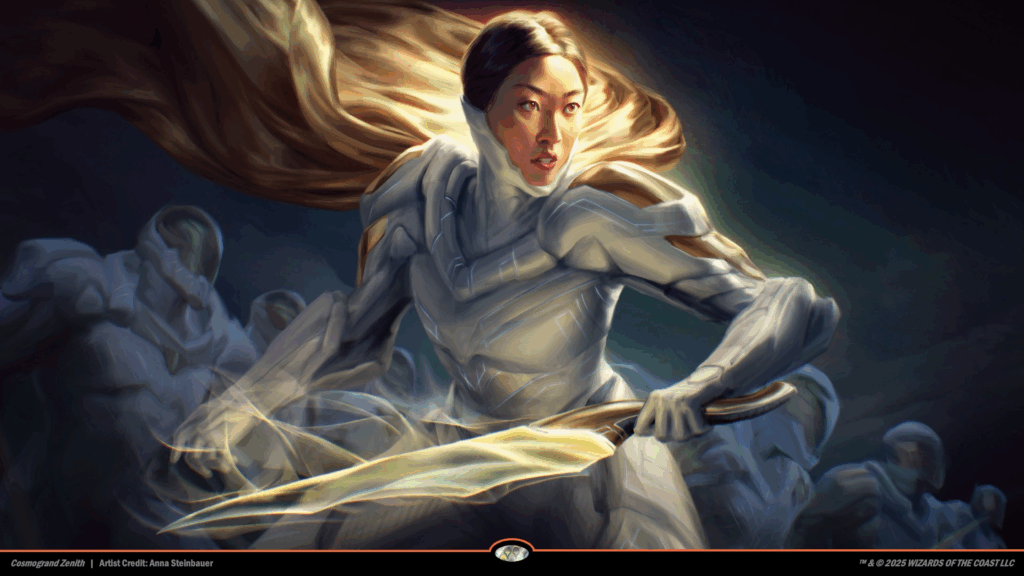
Cosmogrand Zenith by Anna Steinbauer
Sword and Sorcery Beyond the Stars
Magic has always flirted with sci-fi, as Western fantasy and science fiction are intrinsically linked. Arthur C. Clarke’s old adage of that “any sufficiently advanced technology is indistinguishable from magic” can be easily flipped, and the early sci-fi pioneers, from Mary Shelley to Jules Verne to the pulp writers of the 1940’s, treated science as effectively interchangeable with sorcery. Alpha’s Icy Manipulator was a Star Trek prop, Volrath’s Stronghold was more Nostromo than Dracula’s castle, and the Phyrexians were essentially robotic alien invaders (fought off with mechs and “soul bombs” and the Weatherlight going into suborbital flight to haul the Null Moon down to Yawgmoth’s dome).
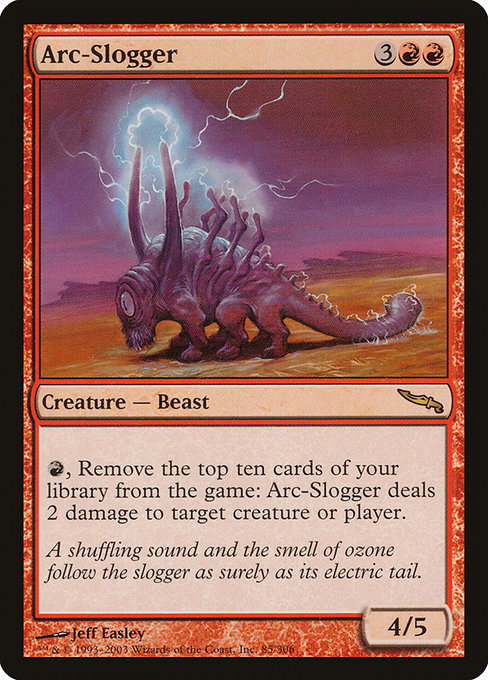
It’s been over twenty years, but I still recall the online arguments about whether Mirrodin spelled the end of Magic as a fantasy card game, which completely ignored the sci-fi DNA present from card one. The Phyrexian Devourers of Magic’s early days, the Ravnican steamworks overseen by the Izzet, Darksteel Colossus as the pinnacle of threats to Tinker out in ancient Extended formats—we have played with robots and Rocket Launchers and Diabolic Machines for as long as there has been a Magic: the Gathering.
Edge of Eternities escalates this—we now can tap our Robot Scouts and Alien Engineers to power up our Spacecraft—but it feels more organic than merely cosmetic or trend-chasing. If Peter Capaldi can wink at us from a card, so can Patrick Stewart. We’ve had Mutants since 2003, and so Aliens are just another stage in that trajectory. If Lorwyn Eclipsed brings us Kithkin with lasers, I’ll have a different take, but after the thematic, ludic, and fiscal success of Neon Dynasty, Wizards deserves a victory lap around an alien solar system.
Rob Bockman (he/him) is a native of South Carolina who has been playing Magic: the Gathering since Tempest block. A writer of fiction and stage plays, he loves the emergent comedy of Magic and the drama of high-level play. He’s been a Golgari player since before that had an official name and is never happier than when he’s able to say “Overgrown Tomb into Thoughtseize,” no matter the format.

